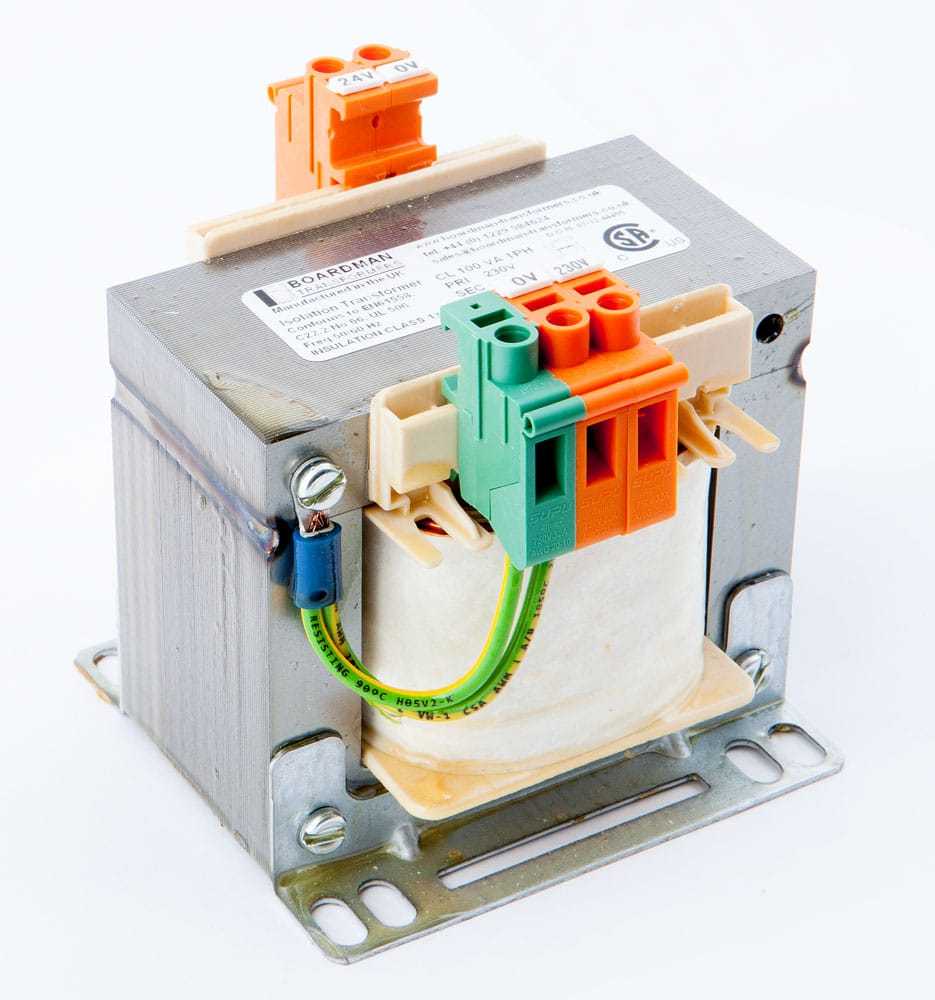CONTROL TRANSFORMER, the majority of industrial motors operate on voltages ranging from 240 to 480 volts. Magnetic control systems, on the other hand, are often powered by 120 volts. To run the control system, a control transformer steps the 240 or 480 volts down to 120 volts. A control transformer is nothing unique, save that most of them have two main windings and one secondary winding. Each main winding has a 240-volt rating, while the secondary winding has a 120-volt rating.
This signifies that the turns ratio between the primary and secondary windings is 2:1 (2 to 1).
Assume that each main winding has 200 turns of wire and each secondary winding has 100 turns. Each main winding has two twists of wire for every one turn of wire in the secondary winding.
The control transformer’s principal windings are designated H1 and H2. H3 and H4 are the labels for the other major windings. The secondary windings are denoted by the letters X1 and X2. If the transformer is to step 240 volts down to 120 volts, the two primary windings are connected in parallel, as illustrated in Figure 6-1.
Figure 6-1 shows the H1 and H3 leads linked together, as well as the H2 and H4 leads connected together. The impact is the same as having only one primary winding with 200 turns of wire in it since the voltage supplied to each primary winding is the same. This indicates that the turns ratio is 2: 1 when the transformer is connected in this manner. The secondary voltage is 120 volts when 240 volts are applied to the primary coil.
Screw terminals are often attached to the primary and secondary leads of a control transformer. Figure 6-3 shows how the H2 and H3 leads are bridged to make connecting the primary winding easier. For example, if the transformer is to be wired for 240 volts, the two primary windings must be linked in parallel, as illustrated in Figure 6-1.
This connection may be formed on the transformer by connecting leads H1 and H3 with one metal link and leads H2 and H4 with another metal link (Figure 6–4).
Figure 6-3 The primary leads have been crossed. Figure 6-4 A 240 volt connection is made using metal links.
The primary windings must be linked in series if the transformer is to be utilized at 480 volts, as illustrated in Figure 6-2. This connection may be created on the control transformer by connecting H2 and H3 with a metal link, as illustrated in Figure 6-5.
Figure 6-6 depicts a typical control transformer.
Instead of two independent windings, some control transformers include a multi-tapped primary (Figure 6–7).
In this example, the transformer is intended to step voltages of 480, 277, 240, or 208 down to 120.
Power Rating
Control transformer power ratings typically vary from 0.75 kilovolt-amperes (75 volt-amperes) to 1 kilovolt-ampere (1000 volt-amperes). Because transformers typically deliver power to inductive equipment such as relay coils and motor starters, the rating is given in volt-amperes rather than watts (Figure 6–8).
The volt-ampere rating of a transformer specifies how much current it can give to control devices. To find the maximum output current of a transformer, divide the volt-ampere rating by the secondary voltage. Figure 6-8 shows a transformer with a power rating of 250 volt-amperes. The maximum secondary current is 2.08 amperes if the secondary voltage is 120 volts.
I= VA/E
I= 250/120
I= 2.08 A
A control transformer with a rating of 75 to 100 voltamperes may be used to power a single motor starter.
Transformers designed to power a whole relay cabinet will have substantially higher ratings, depending on the number of devices and their current needs.
Control Systems (Grounded and Floating)
A control transformer’s secondary winding is frequently grounded on one side (Figure 6–9). When this is done, the control system is said to be grounded. Grounding the control system is a frequent procedure in many businesses. Some technicians feel it might help them solve an issue.
Grounding one side of the control transformer allows one voltmeter lead to be attached to any grounded point and the other voltmeter lead to be used to evaluate voltage at various points throughout the circuit (Figure 6–10).
It is, nevertheless, normal practice not to ground one side of the control transformer. This is commonly known as a floating system. If only one voltmeter probe is attached to a grounded location, the meter reading will be incorrect or meaningless since there is no complete circuit (Figure 6–11). High impedance voltmeters would most likely show some voltage due by ground capacitance and induced voltage produced by nearby magnetic fields. These are commonly known as ghost voltages. No voltage would be indicated using a low impedance meter, such as a plunger type voltage tester.
Figure 6-11 One side of the control transformer is not grounded in floating control systems.
A voltmeter probe connected to a grounded location would provide false results since no full circuit exists.
A float control system may, however, monitor voltage accurately by attaching one voltmeter probe directly to one side of the control transformer (Figure 6–12). Because grounded and floating control systems are both widespread, both will be illustrated in this article.
Figure 6-12 On a floating control system, connecting one meter
probe directly to one side of the transformer will produce precise readings.
Transformer Fusing
Fuse or circuit breakers are commonly used to safeguard control transformers. Protection can be installed on either the main or secondary side of the transformer, and certain businesses want both sides to be protected. NEC
Section 430.72(C) specifies the criteria for transformer protection in motor control circuits.
This provision essentially specifies that control transformers with primary currents less than 2 amps must be protected by an overcurrent device set at no more than 500% of the rated primary current. This high percentage is required due to the high in-rush current associated with transformers. To calculate the rated current of a transformer, divide its volt-ampere rating by its main voltage.
EXAMPLE:
What is the maximum fuse size permissible to protect the primary winding of a 300 volt-ampere control transformer connected to 240 volts?
Solution:
I = VA/E
I = 300/240
I = 1.25 A
Fuse size = 1.25*5
Fuse size = 6.25 A
According to NEC Section 240.6, a standard fuse size is 6 amperes. A fuse of 6 amps would be used.
NEC Section 430.72(C)(2) says that fuse protection in line with 450.3 is permissible also.
This section specifies that NEC Table 430.3 is used to establish primary protection for transformers rated at 600 volts or less (B). According to the table, the rating is 300% of the rated current.
NEC Table 450.3 can also be used to determine the secondary fuse size (B). For fuses protecting a transformer secondary with a current less than 9 amps, the table shows a rating of 167% of the rated secondary current. In the above example, assuming a control voltage of 120 volts, the rated secondary current of the transformer would be 2.5 amperes (300/120). The fuse size would be:
2.5*1.67 = 4.175 A
The closest standard fuse size stated in 240.6 that does not exceed this amount is 3 amperes. Because the secondary does not encounter the high in-rush current of the primary, the secondary fuse size can be set at a lower percentage of the rated current. Because primary and secondary fuse protection is ubiquitous in the industry, the control circuits provided in this article will demonstrate both.














What’s up, I read your blogs daily. Your writing style is
witty, kwep it up!
Aw, this was an extremely nice post. Taking a few minutes and actual
effort to create a very good article
Amazing! This blog looks exactly like my old one! It’s on a entirely different subject but it has pretty much the same layout and design. Superb choice of colors!
Great post. Iwas checking continuously this blog and I’m impressed!
Extremely useful information particularly the last part :
) I care for such info a lot. I was seeking this certain info for a very long time.
Thank you and good luck.
woah this weblog is fantastic I really like
studying your articles. Stay up the good work! You already know,
a lot of persons are hunting round for this info,
you can aid them greatly.
It’s a shame you don’t have a donate button! I’d definitely donate to
tjis brilliant blog! I guess for now i’ll settle for
book-marking and adding your RSS feed to my Google account.
I look forward to fresh updates and will talk about this site with my Facebook group.
Chat soon!
You’re sso interesting! I don’t think I’ve truly read a single thing like
this before. So great to find someone with a few unique thoughts
on this issue. Seriously.. many thanks for starting
this up. This web site is something that is required on the web, someone with a little originality!
What’s up, I want to subscribe for this web site to obtain hottest updates,
therefore where can I do it please help.
When someone searches for his essential thing, so he/she wishes to be available that in detail,
therefore that thing is maintained over here
Somebody necessarily help to make seriously posts I’d state.
This is the very first time I frequented your website page
and soo far? I amazed with the analysis you made to make this particular submit amazing.
Fantastic process!
Wow, incredible blog layout! How long have you been blogging for?
you make blogging look easy. The overall look of your web site
is fantastic, let alone the content!
Excellent blog you’ve got here.. It’s hard too find quality writing like yours nowadays.
I truly appreciate people like you! Take care!
I like the valuable info you supply on your articles.
I will bookmark your weblog and take a look at once more hdre regularly.
I am slightly sure I’ll be informed plenty of new stuff right here!
Good luck for the following!
Excellent, what a website it is! This web sitte presents useful information to us, keep it up.
Very nice post. I just stumbled upon your blog and
wished to mention that I have really enjoyed browsing
your blog posts. In any case I will be subscribing for your feed and I
am hoping you write once more soon.